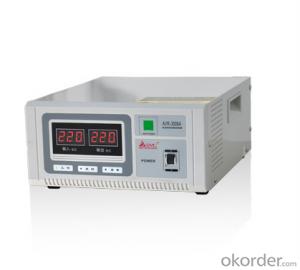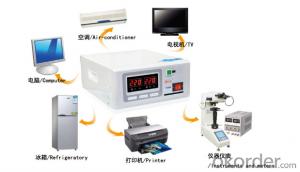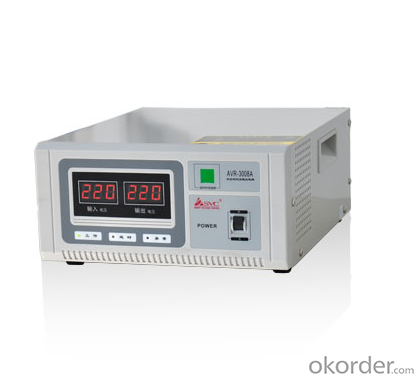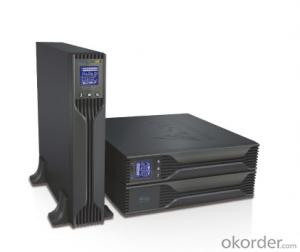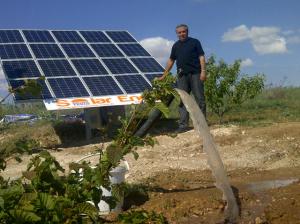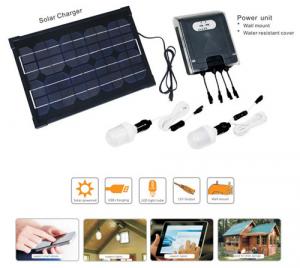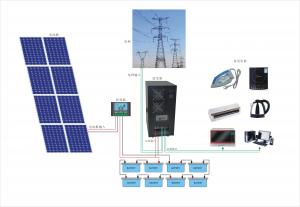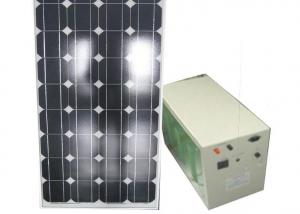Commercial Solar Energy Systems CVoltage Stabilizer Circuit Diagram 5kV Automatic Voltage Stabilizer
- Loading Port:
- China main port
- Payment Terms:
- TT OR LC
- Min Order Qty:
- 20 carton
- Supply Capability:
- 10000 carton/month
OKorder Service Pledge
OKorder Financial Service
You Might Also Like
Unipower circuit diagram 5kv automatic voltage stabilizer

Product Description

| Model | AVR-1008A | AVR-2008A | AVR-3008A | AVR5008A |
| Rated power | 1000VA | 2000VA | 3000VA | 5000VA |
| Display | LED or LCD, depends on user's choice | |||
| TECHNOLOGY | ||||
| Technology | CPU Based Digital Circuit + Transformer + Ralays | |||
| Efficiency | 98% | |||
| Phase | Single | |||
| INPUT | ||||
| Input voltage range & frequency | 140~280VAC/Same as AC | |||
| OUTPUT | ||||
| Output voltage range | 220VAC±10% | |||
| DISPLAY | ||||
| LED digital display status | Input voltage, output voltage | |||
| LED display status | Normal, Display, Fault | |||
| PROTECTION | ||||
| Protections | Over & low voltage, overload, high temperature, short circuit | |||
| ENVIRONMENT | ||||
| Environment of performance | Temperature 0℃~40℃, Humidity 20%~90% | |||
| Noise level | Less than 40dB | |||
| PHYSITAL | ||||
| (kg) / Net weight (kg) | 4.5 | 6.0 | 10 | 13.0 |
| (mm) / Unit dimention (mm) | 251*255*120 | 315*255*120 | ||

1. Wide range of input voltage
The UPS can offer normal and stable service voltage under its input voltage range. When the input voltage is out of its range the machine will switch to battery mode automatically to keep the output power in order to protect the equipment, such as computers, ensure they will not be damaged by the over high or over low voltage, users can continue the operation of equipment for a while or save the data on computers while the power network is abnormal.
2. Wide range of AVR(Automatic voltage regulation)
In the product’s input voltage range and under 3 steps of intelligent AVR function, it can provide a stable output voltage.
3. Automatic self detection when UPS on(LED).
Before the UPS on, red, yellow, blue LED will light up two times by cycle turns, after self detection UPS switch to AC mode/battery mode or working mode.
4. Silence function
In the "battery mode", shortly press the switch to turn off the buzzer. But the battery is about to run out or the load is too heavy, the buzzer sound cannot be muted.
5. Overload protection
In the battery mode, output voltage turn down correspondingly when it is overload, after the capacity of load is lower than the rated power then output voltage will back to rated value, it ensures the UPS will not shut down by abrupt overload which caused by surging current during the computer is working and other equipment is added.
6. Short circuit protection
When the mis-operation caused the load short circuit or computer failure (such as power tube breakdown of switch) cause short circuit, the UPS will shutdown automatically for protection.
7. The low current switch
This UPS adopts low current switch to extend the service life which is longer than conventional battery and high current switch in AC current path.
8. Automatic charging
There are two charging mode, charging time is faster than ordinary charging mode, higher efficiency, and greatly prolonging the service life of the battery.
9. With a bypass output
Independent bypass output socket for external printers or scanners of computer peripherals, with surge protection of the load.
- Q: How much sunlight is needed for a solar energy system to work effectively?
- The effectiveness of a solar energy system is influenced by several factors that cause the required amount of sunlight to vary. These factors include the efficiency of the solar panels, the location, the angle and orientation of the panels, and the time of year. To achieve maximum effectiveness, solar panels should ideally receive uninterrupted direct sunlight for a significant portion of the day. Direct sunlight refers to sunlight that reaches the panels without any obstacles like shadows from nearby buildings or trees. This unobstructed sunlight provides the highest energy level, thus optimizing the system's efficiency. Nevertheless, solar panels can still generate electricity even when direct sunlight is not available. They can produce energy in cloudy conditions or when sunlight is scattered. Although energy production may decrease in these situations, it is still possible to generate a substantial amount of electricity, especially due to advancements in solar panel technology. Geographical location is also critical in determining the amount of sunlight available. Areas closer to the equator generally receive more sunlight throughout the year, while regions farther from the equator may experience shorter days during certain seasons. Consequently, solar energy systems in equatorial regions may require less sunlight to operate effectively compared to those in areas with less sunlight. The angle and orientation of the solar panels also affect the system's effectiveness. Panels that are angled towards the sun and facing south in the northern hemisphere (or north in the southern hemisphere) maximize their exposure to sunlight. By optimizing the panel's position, the system can capture the highest possible amount of sunlight, thus enhancing its effectiveness. Lastly, the time of year impacts the sunlight received by a solar energy system. During summer months, when days are longer and the sun is higher in the sky, solar panels have greater access to sunlight, making them more effective. Conversely, during winter, when days are shorter and the sun is lower in the sky, the system may receive less sunlight, thus affecting its performance. In conclusion, the required amount of sunlight for a solar energy system to function effectively depends on various factors, including panel efficiency, location, orientation, and time of year. Although direct sunlight is preferable, solar panels can still generate electricity under cloudy or scattered sunlight conditions. Consulting with a solar energy professional is recommended to determine the specific sunlight requirements based on these factors for a particular system.
- Q: What is the role of grounding systems in a solar energy system?
- Grounding systems are essential in a solar energy system for safety and protection against electrical faults and lightning strikes. The purpose of grounding is to connect electrical equipment and components to the Earth's surface, creating a path with low impedance for electrical faults to flow. This prevents the accumulation of excessive voltages that could be dangerous for both people and equipment. In a solar energy system, grounding serves multiple important functions. Firstly, it ensures protection against electrical shock by redirecting fault currents into the ground, thus minimizing the risk of injury. This is particularly crucial since solar panels and inverters are exposed to sunlight and can be accessed by people during maintenance or repairs. Secondly, grounding helps in dissipating static electricity that might build up in the system, especially in panels and mounting structures. If not properly controlled, static electricity can cause harm to sensitive electronics and even lead to fires or explosions. By grounding these components, static charges are safely discharged into the ground. Furthermore, grounding systems play a critical role in safeguarding the solar energy system from lightning strikes. Lightning carries a tremendous amount of electrical energy, and without adequate grounding, it can cause significant damage to the system. Grounding systems provide a low-resistance path for lightning to follow, guiding the electrical energy safely into the ground. This protects the solar panels, inverters, and other equipment from harm. Lastly, grounding systems help maintain a stable electrical reference point for the system. This is crucial for accurate monitoring, control, and efficient operation of the solar energy system. Grounding minimizes electromagnetic interference (EMI) and noise that can impact the performance of sensitive electronic components, ensuring optimal functioning of the system. In summary, the role of grounding systems in a solar energy system is to prioritize safety by protecting against electrical shocks, dissipating static electricity, and safeguarding against lightning strikes. Additionally, grounding systems maintain a stable electrical reference point, promoting efficient operation and reducing the risk of equipment damage.
- Q: How do solar energy systems affect the insurance premiums of a property?
- Solar energy systems can potentially affect insurance premiums of a property in a positive way. Installing solar panels can increase the value of a property, which may result in higher replacement cost coverage and thus slightly higher premiums. However, many insurance companies offer discounts or specialized policies for homes with solar energy systems, as they are considered less risky due to reduced reliance on traditional power sources and potential for energy savings. Ultimately, the impact on insurance premiums will vary depending on several factors, including the location, size, and efficiency of the solar energy system.
- Q: How do solar energy systems impact the aesthetics of a home?
- The aesthetics of a home can be influenced by solar energy systems, which can have both positive and negative effects. On the positive side, solar panels can contribute to a sleek and modern design, adding a futuristic and environmentally-friendly touch to the overall appearance of a home. Additionally, some individuals find solar panels visually appealing, especially when they seamlessly blend into the house's architecture. Moreover, solar energy systems can enhance the curb appeal of a home, making it stand out from others in the neighborhood. This is particularly advantageous for homeowners who wish to demonstrate their dedication to sustainability and clean energy. However, it is important to note that some people may consider solar panels obtrusive. Traditional solar panels are typically large and can disrupt a home's design symmetry and visual harmony. This is especially true for historic or architecturally significant homes, where the addition of solar panels might be seen as detracting from the original aesthetic. To address this concern, advancements in solar technology have resulted in the creation of more aesthetically pleasing alternatives, such as solar roof tiles or transparent solar panels. These options blend more seamlessly with a home's overall appearance and are less noticeable than traditional solar panels. Ultimately, the impact of solar energy systems on a home's aesthetics will depend on personal preferences, the house's design, and how well the solar panels are integrated into the overall architecture. By carefully considering the design and placement of solar panels, any negative aesthetic impact can be minimized, ensuring that they become a harmonious addition to the home's visual appeal.
- Q: How do solar energy systems impact the quality of air and water?
- The quality of air and water is positively affected by solar energy systems. Unlike coal or gas, which are traditional energy sources, solar energy does not release harmful emissions or pollutants, resulting in a significant decrease in air pollution. This not only enhances air quality but also aids in reducing the greenhouse gas emissions that contribute to climate change. Solar energy systems also have a minimal impact on water quality. Although some water is utilized during the manufacturing process of solar panels, the quantity used is considerably lower compared to other energy sources like fossil fuels. Furthermore, solar energy does not require water for its operation, unlike thermal power plants that consume large amounts of water for cooling purposes. Additionally, the use of solar energy diminishes reliance on fossil fuels, which are often obtained through environmentally destructive methods such as fracking or oil spills. Shifting to solar energy significantly reduces the risk of water contamination resulting from these activities. Moreover, solar energy systems contribute to the conservation of water resources. Traditional energy sources like coal or gas power plants necessitate substantial amounts of water for operation, which can strain local water supplies and ecosystems. On the other hand, solar energy generation does not require water, thus aiding in the conservation of water resources and alleviating stress on aquatic ecosystems. In conclusion, solar energy systems have a positive impact on both air and water quality. They aid in reducing air pollution, greenhouse gas emissions, and the risk of water contamination, while also conserving water resources. By embracing solar energy, we can advocate for a cleaner and healthier environment for future generations.
- Q: Can solar energy systems be used for powering airports or transportation hubs?
- Certainly, airports or transportation hubs can utilize solar energy systems for power. Solar energy represents a renewable and sustainable power source that can be obtained by installing solar panels. These panels absorb sunlight and convert it into electricity, which can then be utilized to power various operations within airports or transportation hubs. By implementing solar energy systems, a constant and dependable power source can be provided for running lighting systems, air conditioning, heating, ventilation systems, and other electrical equipment. This reduces reliance on conventional energy sources and diminishes the carbon footprint of these facilities. Additionally, airports and transportation hubs often possess expansive roof areas, parking lots, and open spaces, making them ideal locations for solar panel installation. These vast areas can generate a significant amount of solar power, making these facilities excellent candidates for solar energy systems. In fact, several airports and transportation hubs worldwide have already adopted solar energy systems. For instance, Cochin International Airport in India is the world's first airport to be fully powered by solar energy, producing more energy than it consumes. Similarly, Denver International Airport in the United States has installed a large array of solar panels to meet its power requirements. Employing solar energy systems in airports and transportation hubs not only cuts operating costs but also supports environmental sustainability. It aids in mitigating greenhouse gas emissions, reducing dependence on fossil fuels, and contributing to the global shift towards clean and renewable energy sources. In summary, solar energy systems present a feasible and efficient solution for powering airports and transportation hubs, offering various benefits like cost savings, environmental conservation, and energy self-sufficiency.
- Q: What is a solar battery?
- A solar battery is a device that stores the excess energy generated by solar panels during the day for later use. It allows for the utilization of solar power even when the sun is not shining, ensuring a constant and reliable energy supply.
- Q: How does the color of solar panels affect energy production?
- The energy production of solar panels is not significantly affected by their color. The color of solar panels mainly depends on the materials used in their construction, such as silicon or thin film. These materials have different absorption properties, but they are designed to efficiently absorb sunlight and convert it into electricity regardless of the color. However, it is important to note that darker-colored solar panels may absorb slightly more heat from the sun compared to lighter-colored ones. This can result in a slight reduction in overall efficiency as the panel's temperature increases. To address this issue, manufacturers often employ various cooling techniques, such as elevating the panels or incorporating cooling systems, to maintain optimum operating temperatures. In the end, the primary factor that influences energy production in solar panels is the amount and intensity of sunlight they receive, rather than their color. Factors such as the installation angle, geographical location, shading, and cleanliness of the panels have a much greater impact on their energy output.
- Q: Do solar panels work on cloudy days?
- Yes, solar panels do work on cloudy days, although their efficiency may be reduced compared to sunny days. While they generate less electricity in overcast conditions, they can still produce a significant amount of power due to the diffuse sunlight that reaches them.
- Q: Can solar energy systems be used for powering streetlights?
- Yes, solar energy systems can be used for powering streetlights.
Send your message to us
Commercial Solar Energy Systems CVoltage Stabilizer Circuit Diagram 5kV Automatic Voltage Stabilizer
- Loading Port:
- China main port
- Payment Terms:
- TT OR LC
- Min Order Qty:
- 20 carton
- Supply Capability:
- 10000 carton/month
OKorder Service Pledge
OKorder Financial Service
Similar products
Hot products
Hot Searches
Related keywords
